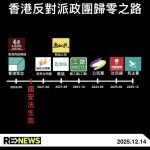June 15, 2018
On June 8, messages circulated on social media that truck drivers across China were going on strike on the 10th. This came with a feeling of deja vu, as a similar call for strike had happened on April 25, when crane operators announced a strike for May 1. And, as happened with the crane operators earlier, the truckers’ strike never materialized. The day came, and the strike was called off.
One can guess that the strike leaders were controlled by the stability-maintenance authorities in their locality. But the effect again mirrored that of the canceled crane operators’ strike: upon hearing the call to action, truckers gathered and demonstrated on the days before the appointed time. They hailed from all over the country: Xiushui in Jiangxi province; Hefei, Fuyang; Wuhu in Anhui province; Lianyungang in Jiangsu province; Ningbo in Zhejiang province; Tongren in Guizhou province; Jiading in Shanghai; Wuhan in Hubei; Liaocheng in Shandong; Chengdu in Sichuan; Chongqing; in addition to other cities and provinces.
By announcing strikes on one day but carrying the action earlier, they made “a feint in the east and attacking in the west” [a well known Chinese idiom and military strategy], successfully staging their actions that would otherwise be suppressed.
The truck drivers staged motor protests on the 8th and 9th of June to demand lower gas prices, higher pay for their freight, abolishing excessive road and bridge tolls, and an end to arbitrary fees and fines. They also stood out to oppose the steady monopolization of the logistics industry.
Over a couple days of resistance, the truckers made the whole country aware of their plight. These men practically live in their trucks, leaving their wives and children for a life on the road. They work over 12 hours a day in miserable conditions and subpar safety. Adding to this are their many run-ins with the authorities, who impose upon them fees both legal and illegal. As their income drops, they doggedly maintain their living by accepting ever heavier and riskier loads.
And it’s not just the drivers. Workers throughout the logistics chain toil for next to nothing, even with the exorbitant rates suppliers pay for Chinese shipping (over twice the price of American rates). The costs are passed on to the consumers, but where does the money end up?
Take the Beijing-Xi’an line as an example: a round trip costs about 21,500 yuan, of which 14,500 yuan covers gas. The rest goes to the five-day costs of living, maintenance work and parts, annual registration and vehicle inspection fees, insurance, and various fines one can expect to be slapped with by the authorities. In the end, there is not much left for the truck owners and/or the drivers to make a profit or earn a decent wage.
The root cause of the truckers’ conditions stem from the government’s monopolization of the logistic industry’s lifeblood — fuel and highways — which feeds rent-seeking behavior on the part of the transport police and highway administration. And then there is the immediate factor in the outbreak of the truckers’ strike: the imbalance and inequality of capital and labor within the logistics sector.
China boasts a fleet of about 15 million trucks demanding two drivers each, making around 30 million truckers across the country. Some own the vehicles they drive; others rent trucks, and others don’t personally drive anymore and provide their trucks to the second group. Most drivers are renters. The supply side of the logistics sector is diverse, as is the demand side — the enterprises and goods owners. This plurality of supply and demand once made for an essentially free arena of competition, but recent and sudden shifts in the industry have led to the rise of monopolies.
The shift came with the merger of two logistics giants — Yunmanman [满运软件科技有限公司] of Jiangsu Province and Guiyang’s Truck Alliance, Inc. [货车帮科技有限公司] — to form the Manbang Group. Yunmanman, established in 2013, was the first logistics company in China to incorporate cloud computing, big data, and AI technologies in its platform. It employs four million drivers and owns one million trucks in 315 cities across the country. The comparably-sized Truck Alliance, Inc. boasts a formidable nationwide data infrastructure. It provides comprehensive service for the logistics network across 4.5 million trucks, and works with 88,000 supply partners.
Following the merger, CEO and board chairman Wang Gang (王刚) of Didi Chuxing, CEO Luo Peng (罗鹏) of Truck Alliance, Inc, and Zhang Hui (张晖) of Yunmanman became joint directors of the new Manbang Group. The original companies have remained distinct entities with their own brands, but they now work in tandem to dominate the industry.
Data from Manbang indicates that 5.2 of 7 million mainline fleet trucks in China are now registered with the conglomerate; and around 125 of the nation’s 150 logistics companies are Manbang affiliates. Every day 18.28 billion tons of freight is moved around the country, of which Manbang handles 13.59 billion.
On April 24, 2018, the Manbang Group carried out its first round of financing, worth about $1.9 billion. After the merger, its stock value is expected to break $6 billion.
From May 26 to May 29, Manbang made its first post-merger appearance at the China International Big Data Industry Expo 2018 that was held in Guiyang’s International Convention & Convention Center. According to Reuter’s Chinese-language service, “aside from providing a service that matches trucks to goods, Manbang also became the biggest platform for transport vehicles and all-in-one vehicle support covering services like vehicle oil, electronic throttle control (ETC) systems, vehicle replacement, financing, insurance, or site development. This year Manbang Group has seen successful with its online transaction platform, with the value of transactions reaching hundreds of millions of yuan per month.”
The merger of Yunmanman with Trucking Alliance Inc. brought about a fundamental change in industrial relations within the logistics sector. First, Manbang introduced an annual fee of somewhere between 1680 and 3000 yuan directed at the truck drivers and related information service personnel, which forced the hands of many who had already become dependent on the app for their business.
The second and more explosive event occurred on June 4, when the Truck Alliance app implemented a client update that made it impossible to receive information in real time. Job pricing was fully automated, depriving users of the ability to set their own prices. As a part of the new merger, Truck Alliance was blatantly and openly exerting control over its customers with impunity. Suppose a supplier pays Manbang 1000 yuan, then of that sum the driver gets only 800 yuan and Manbang pockets the rest. This situation caused an uproar among vehicle owners, suppliers, drivers, and other industry personnel.
The crux of the matter is that Manbang is a third party service brokerage platform that not only collects an annual service fee for its information, but has reached into the transaction between trucker and supplier and take a cut from it. It’s gone from information provider to hegemon of the logistics industry. It uses its monopoly on supply and demand data to force truck operators and drivers into paying a “transaction commission” outside the normal app service fee. Manbang doesn’t expend any capital or labor to collect this massive and blatantly exploitative profit. Looking at the plans drafted by Manbang’s nine operations departments, it’s clear that it wants to completely have its way with the industry, forcing all other capital investors (vehicle owners) and laborers (truckers) into submission.
This is adding insult to injury for the truck owners and drivers already suffering under the monopolistic business landscape and predatory government authorities. The June 4 client app update was the last straw.
The actions of the truckers across China is remarkable and praiseworthy:
This is not a sudden outbreak, but the fruits of long-term, built-up resentment. Truckers have exposed the corruption of the logistics industry before, such as when they called for strikes on November 11, 2015, and April 16, 2017. They organized nationwide and local groups on QQ and WeChat, and formed unofficial logistics associations and alliances to begin defending their rights. It can be seen as a nascent truckers’ union.
This is an industry-wide action following on the heels of crane operators’ protests at the end of April. The strength, effectiveness, and bargaining potential of such collective actions are by no means something that could be achieved by one enterprise alone. Collective actions like group bargaining are the staple in the labor movements of many other countries. It is satisfying to see Chinese workers embark on the labor movement’s righteous path.
The alliance of truck drivers form as a permanent organized and law-abiding force in the logistic industry. These cooperatives and other labor organizations are necessary to counter huge conglomerates like Manbang and protect small capital investors and truckers. Without camaraderie between the workers, the industry is doomed to be monopolized.
The government is obligated to guarantee the rights of the workers to assemble and organize. It also has a responsibility to protect disadvantaged groups in the industry and the rights of workers to unionize. Only in this way will competition be fair, and as the industry makes progress as a whole, it will be possible to ensure legal rights and benefits like proper wages, working hours and conditions, and social security.
Tan Jiangying is a labor scholar in China.











